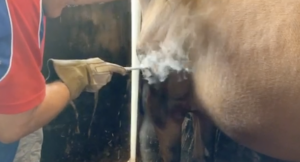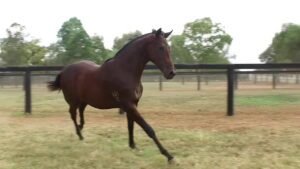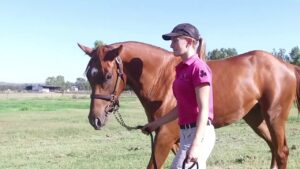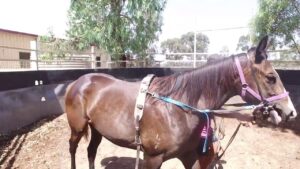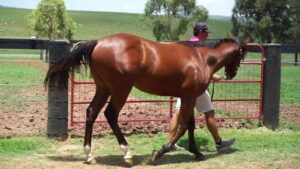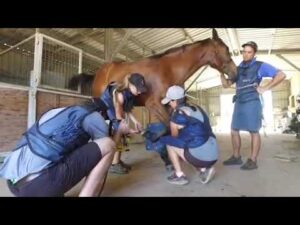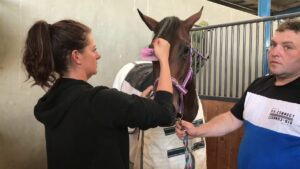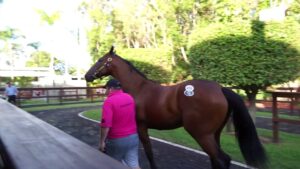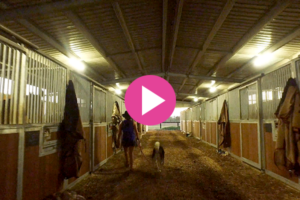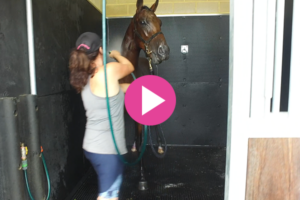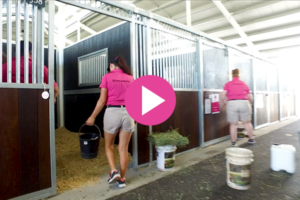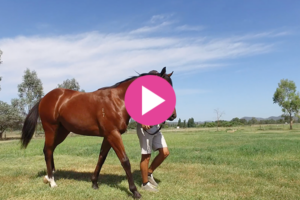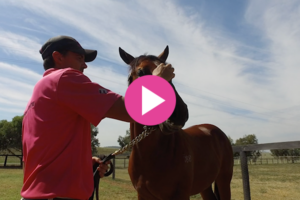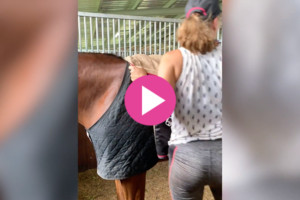From Birth to Yearling
Stages of growth: Day 1 to Sale

Foaling begins
 Mares are watched 24/7 as their due date approaches. Their teats become engorged and ‘’waxing” (presence of colostrum which has a honey-like appearance) occurs a few days prior to foaling. When the mare shows the first signs of labour she is brought into a foaling yard so she has a clean, safe and quiet place to foal. We are present during the foaling and check the presentation but most mares foals without difficulty and it is best to allow them to foal undisturbed.
Mares are watched 24/7 as their due date approaches. Their teats become engorged and ‘’waxing” (presence of colostrum which has a honey-like appearance) occurs a few days prior to foaling. When the mare shows the first signs of labour she is brought into a foaling yard so she has a clean, safe and quiet place to foal. We are present during the foaling and check the presentation but most mares foals without difficulty and it is best to allow them to foal undisturbed. Foal is born
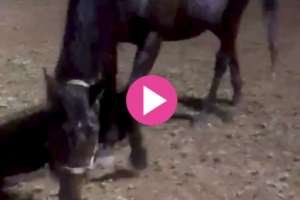 Once the foal is delivered we quietly monitor them and allow the mare and foal to bond undisturbed. The foal should make attempts to stand within 30 minutes and nurse within two hours. The mare should pass her placenta within three hours and we examine it to make sure it is intact. We assess the colostrum quality of the mare and ensure the foal receives adequate nutrition and antibodies to give them a good start to life.
Once the foal is delivered we quietly monitor them and allow the mare and foal to bond undisturbed. The foal should make attempts to stand within 30 minutes and nurse within two hours. The mare should pass her placenta within three hours and we examine it to make sure it is intact. We assess the colostrum quality of the mare and ensure the foal receives adequate nutrition and antibodies to give them a good start to life. Early education
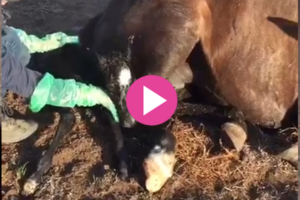 Within the first few days of life we start handling the young foals. A head collar is placed and they are taught to lead. This early education and human interaction is crucial for the rest of the foal’s life and we like to commence the handling process early to ensure it is stress-free for our young horses.
Within the first few days of life we start handling the young foals. A head collar is placed and they are taught to lead. This early education and human interaction is crucial for the rest of the foal’s life and we like to commence the handling process early to ensure it is stress-free for our young horses. First farrier visit
 The young foals get their feet trimmed for the first time at 10-14 days of age. Our farrier and vet perform weekly conformation exams to assess each foal’s progress. It is crucial to address any conformation issues within the first few months of life before the growth plates of the distal limb close.
The young foals get their feet trimmed for the first time at 10-14 days of age. Our farrier and vet perform weekly conformation exams to assess each foal’s progress. It is crucial to address any conformation issues within the first few months of life before the growth plates of the distal limb close. Conformation corrections
 There are different methods utilised to help correct angular limb deformities. The farrier trims the foals every few weeks and sometimes places an equitane extension under the hoof to help support the limb and encourage growth to correct any abnormality. If more intensive treatment is required we are very fortunate to have a state-of-the-art surgical facility on site where transphyseal screw surgeries can be performed.
There are different methods utilised to help correct angular limb deformities. The farrier trims the foals every few weeks and sometimes places an equitane extension under the hoof to help support the limb and encourage growth to correct any abnormality. If more intensive treatment is required we are very fortunate to have a state-of-the-art surgical facility on site where transphyseal screw surgeries can be performed. Weaning
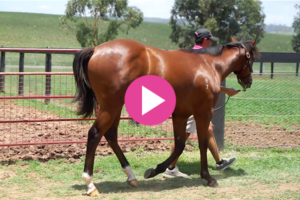 As the foals get older, they become more mature and independent. At approximately 6 months of age they are weaned from their mothers. They come into the barn for a week where their education continues. They receive further handling and learn to lead without the guidance of the mare. They are then turned out into a paddock with a nanny, who helps them to settle and reduce any anxiety.
As the foals get older, they become more mature and independent. At approximately 6 months of age they are weaned from their mothers. They come into the barn for a week where their education continues. They receive further handling and learn to lead without the guidance of the mare. They are then turned out into a paddock with a nanny, who helps them to settle and reduce any anxiety. Ongoing education
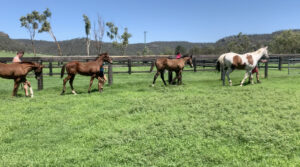 Each month, the weanlings come into the barn for a few days of regular handling and continuation of their education. They learn to go on the walker and get rugged which gives them a head start when they begin their yearling sale preparation and a solid foundation for their future racing careers.
Each month, the weanlings come into the barn for a few days of regular handling and continuation of their education. They learn to go on the walker and get rugged which gives them a head start when they begin their yearling sale preparation and a solid foundation for their future racing careers. Sale selection
 Representatives of the sale companies begin visiting the farm from August to inspect the yearlings. In consultation with the sales companies and our clients, we decide which sale is the most suitable market to present each individual horse. Factors taken into consideration include physique, pedigree and precociousness.
Representatives of the sale companies begin visiting the farm from August to inspect the yearlings. In consultation with the sales companies and our clients, we decide which sale is the most suitable market to present each individual horse. Factors taken into consideration include physique, pedigree and precociousness. Yearling Preparation
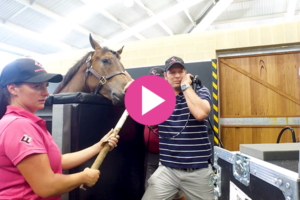 By now the young horses have celebrated their first birthday (August 1st) and will soon come in to begin their yearling sale preparation. Their growth and development during this period is paramount for their future athletic careers. We monitor their progress each day and adapt their nutrition and exercise accordingly.
By now the young horses have celebrated their first birthday (August 1st) and will soon come in to begin their yearling sale preparation. Their growth and development during this period is paramount for their future athletic careers. We monitor their progress each day and adapt their nutrition and exercise accordingly.
Stage 1
Foaling begins
Mares are watched 24/7 as their due date approaches. Their teats become engorged and ‘’waxing” (presence of colostrum which has a honey-like appearance) occurs a few days prior to foaling. When the mare shows the first signs of labour she is brought into a foaling yard so she has a clean, safe and quiet place to foal. We are present during the foaling and check the presentation but most mares foals without difficulty and it is best to allow them to foal undisturbed.
Stage 2
Foal is born

Once the foal is delivered we quietly monitor them and allow the mare and foal to bond undisturbed. The foal should make attempts to stand within 30 minutes and nurse within two hours. The mare should pass her placenta within three hours and we examine it to make sure it is intact. We assess the colostrum quality of the mare and ensure the foal receives adequate nutrition and antibodies to give them a good start to life.
Stage 3
Early education
 Within the first few days of life we start handling the young foals. A head collar is placed and they are taught to lead. This early education and human interaction is crucial for the rest of the foal’s life and we like to commence the handling process early to ensure it is stress-free for our young horses.
Within the first few days of life we start handling the young foals. A head collar is placed and they are taught to lead. This early education and human interaction is crucial for the rest of the foal’s life and we like to commence the handling process early to ensure it is stress-free for our young horses.
Stage 4
First farrier visit
The young foals get their feet trimmed for the first time at 10-14 days of age. Our farrier and vet perform weekly conformation exams to assess each foal’s progress. It is crucial to address any conformation issues within the first few months of life before the growth plates of the distal limb close.
Stage 5
Conformation corrections
 There are different methods utilised to help correct angular limb deformities. The farrier trims the foals every few weeks and sometimes places an equitane extension under the hoof to help support the limb and encourage growth to correct any abnormality. If more intensive treatment is required we are very fortunate to have a state-of-the-art surgical facility on site where transphyseal screw surgeries can be performed.
There are different methods utilised to help correct angular limb deformities. The farrier trims the foals every few weeks and sometimes places an equitane extension under the hoof to help support the limb and encourage growth to correct any abnormality. If more intensive treatment is required we are very fortunate to have a state-of-the-art surgical facility on site where transphyseal screw surgeries can be performed.
Stage 6
Weaning
 As the foals get older, they become more mature and independent. At approximately 6 months of age they are weaned from their mothers. They come into the barn for a week where their education continues. They receive further handling and learn to lead without the guidance of the mare. They are then turned out into a paddock with a nanny, who helps them to settle and reduce any anxiety.
As the foals get older, they become more mature and independent. At approximately 6 months of age they are weaned from their mothers. They come into the barn for a week where their education continues. They receive further handling and learn to lead without the guidance of the mare. They are then turned out into a paddock with a nanny, who helps them to settle and reduce any anxiety.
Stage 7
Stage 8
Ongoing education
 Each month, the weanlings come into the barn for a few days of regular handling and continuation of their education. They learn to go on the walker and get rugged which gives them a head start when they begin their yearling sale preparation and a solid foundation for their future racing careers.
Each month, the weanlings come into the barn for a few days of regular handling and continuation of their education. They learn to go on the walker and get rugged which gives them a head start when they begin their yearling sale preparation and a solid foundation for their future racing careers.
Stage 9
Sale selection
 Representatives of the sale companies begin visiting the farm from August to inspect the yearlings. In consultation with the sales companies and our clients, we decide which sale is the most suitable market to present each individual horse. Factors taken into consideration include physique, pedigree and precociousness.
Representatives of the sale companies begin visiting the farm from August to inspect the yearlings. In consultation with the sales companies and our clients, we decide which sale is the most suitable market to present each individual horse. Factors taken into consideration include physique, pedigree and precociousness.
Stage 10
Yearling Preparation
 By now the young horses have celebrated their first birthday (August 1st) and will soon come in to begin their yearling sale preparation. Their growth and development during this period is paramount for their future athletic careers. We monitor their progress each day and adapt their nutrition and exercise accordingly.
By now the young horses have celebrated their first birthday (August 1st) and will soon come in to begin their yearling sale preparation. Their growth and development during this period is paramount for their future athletic careers. We monitor their progress each day and adapt their nutrition and exercise accordingly. A yearling preparation
11 weeks of a preparation

Grooming the yearlings
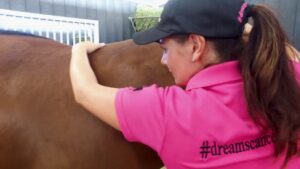 Each afternoon the yearlings are groomed. This helps ensure they each have a healthy coat by the time inspections begin but also acts as a form of massage therapy which stimulates healthy blood circulation and muscle recovery post-exercise. This relaxing time also helps form a bond between the horse and the handler.
Each afternoon the yearlings are groomed. This helps ensure they each have a healthy coat by the time inspections begin but also acts as a form of massage therapy which stimulates healthy blood circulation and muscle recovery post-exercise. This relaxing time also helps form a bond between the horse and the handler. Pre-sale Scoping
 A racehorse needs sufficient oxygen to race to their full potential. Scoping involves the insertion of a flexible endoscope with a camera attached through one nostril to the back of the throat. This technique allows a visual examination of the structure and function of the larynx and upper respiratory tract.
A racehorse needs sufficient oxygen to race to their full potential. Scoping involves the insertion of a flexible endoscope with a camera attached through one nostril to the back of the throat. This technique allows a visual examination of the structure and function of the larynx and upper respiratory tract.
Week 1
Week 2
Grooming the yearlings
 Each afternoon the yearlings are groomed. This helps ensure they each have a healthy coat by the time inspections begin but also acts as a form of massage therapy which stimulates healthy blood circulation and muscle recovery post-exercise. This relaxing time also helps form a bond between the horse and the handler.
Each afternoon the yearlings are groomed. This helps ensure they each have a healthy coat by the time inspections begin but also acts as a form of massage therapy which stimulates healthy blood circulation and muscle recovery post-exercise. This relaxing time also helps form a bond between the horse and the handler.
Week 3
Week 4
Week 5
Week 6
Week 7
Week 8
Week 9
Week 10
Pre-sale Scoping
 A racehorse needs sufficient oxygen to race to their full potential. Scoping involves the insertion of a flexible endoscope with a camera attached through one nostril to the back of the throat. This technique allows a visual examination of the structure and function of the larynx and upper respiratory tract.
A racehorse needs sufficient oxygen to race to their full potential. Scoping involves the insertion of a flexible endoscope with a camera attached through one nostril to the back of the throat. This technique allows a visual examination of the structure and function of the larynx and upper respiratory tract. A day in the life
of a yearling in sales preparation


